It’s really easy to get excited with the higher-end video cards and get hung up in trying to keep up with others to have the flashiest or fastest PCs. But the reality is even in the latest Steam hardware survey that 58% of stem users are running a resolution of 1080p and another 8% of users running below that. With that in mind, there are a LOT of people who don’t need the latest and greatest but may still need an upgrade to keep up with current games at 1080p. Well, there are a few cards targeted at that market, the Radeon RX 6500 XT and Nvidia RTX 3050. Nvidia even leaned into this with a new 6GB model earlier this year. Well, today I’m going to check out both the Radeon RX 6500 XT 8GB and also compare it with the RTX 3050 6GB which is in the same budget price range, and see how they perform. Which would be a good pickup when doing a budget build, let’s find out.
Product Name: PowerColor RX 6500 XT Fighter 8GB
Review Sample Provided by: AMD
Written by: Wes Compton
Amazon Affiliate Link: HERE
|
Specifications |
|
|
Graphics Engine |
AXRX 6500 XT 8GBD6-DH/OC |
|
Video Memory |
8GB GDDR6 |
|
Stream Processor |
1024 Units |
|
Engine Clock(OC) |
up to 2685MHz(Game)¹ up to 2825MHz(Boost)² |
|
Memory Speed |
18.0 Gbps |
|
Memory Interface |
64-bit |
|
DirectX® Support |
12 |
|
Bus Standard |
PCIE 4.0 x4 |
|
Standard Display Connectors |
1 x HDMI 2.1 , 1 x DisplayPort 1.4 |
|
OpenGL |
Support |
|
CrossFireX™ Technology |
Support (DirectX® 12/Vulkan™) |
|
AMD Stream Technology |
Support |
|
AMD Eyefinity Technology |
Support |
|
Maximum Resolution |
VGA DVI DisplayPort 7680×4320 HDMI 7680×4320 |
|
Power Specs + Board Dimensions |
|
|
Board Dimensions |
180*111*40mm 192*126*41mm(with bracket) |
|
Minimum System Power requirement (W) |
450W |
|
Extension Power Connector |
One 8-pin PCI Express Power Connector |
|
Warranty |
2 Years |
Before getting into testing I did also run GPUz to double-check that our clock speeds matched up with the specifications. The PowerColor RX 6500 XT Fighter 8GB has a boost clock speed of 2825 MHz which is a hair above the reference boost clock speed of 2815 MHz and the 2825 MHz clock speed in GPUz matches PowerColor’s specifications as well.

Packaging
The box for the PowerColor RX 6500 XT Fighter 8GB has earth in the background along with the moon and other stars. Along the bottom, they have the Radeon wraparound which has the RX 6500 XT model name. Then for the PowerColor branding up top, you have the logo in the top center and then the Fighter logo is the largest font and across the entire center of the box. The bottom left corner lets you know that this card is focused on 1080p performance and has 8GB of VRAM using PCIe 4.0 for its interface. I wish the background featured a picture of the card itself, but beyond that, all of the information you need on the front is there. On the back of the box, the wrap-around continues with a list of AMD features. They have two pictures back here, one touching on the two ball bearing design for the fans and the other letting you know that the fans turn off at lower loads to keep things silent. Still no pictures of the card itself however or any specifications like the card's size or display connections which would be good information when shopping in retail.


Card Layout and Photos
Being a budget-focused card, the PowerColor RX 6500 XT Fighter 8GB keeps things simple with its compact all-black design. They have a flat fan shroud which does the job but has no extra styling to it and the two axial fans push the air down into the cooler. The only visible branding on the fan side are the PowerColor logos on the center of the fans but there is a logo up on the top edge of the card as well.


One of the best features of these 1080p-focused cards is that we don’t have to worry about the fitment issues that the high-end huge cards have. The PowerColor RX 6500 XT Fighter 8GB comes in at 180mm for total length. For height, it is 111mm tall which is just 1mm over the “standard” PCI height. Then for thickness, it is a proper 2-slot card at 40mm total thickness. This is going to fit in just about any build short of a few of the cases that need the 6-inch ITX length GPUs that hit the SFF scene years ago but have mostly gone away.


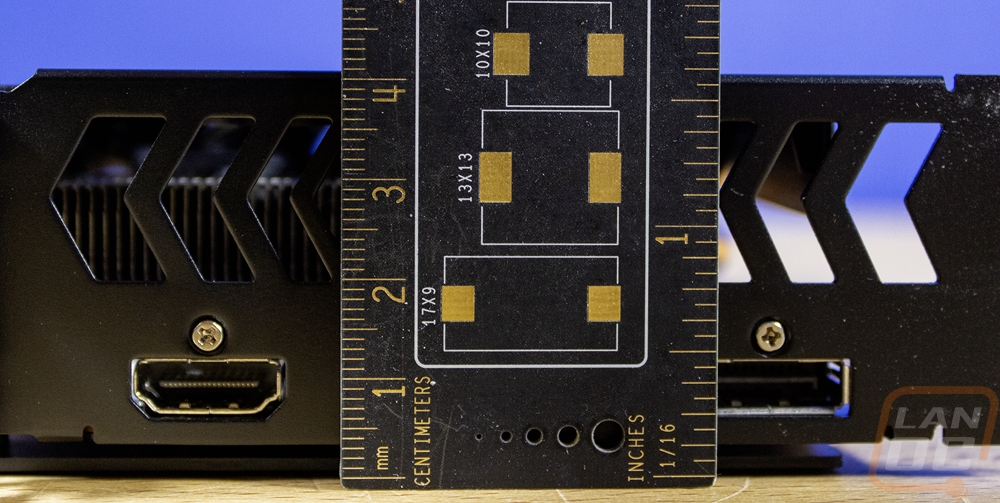
The RX 6500 XT Fighter 8GB has two cooling fans that blow down into the heatsink and if we look closely we can see the aluminum sheet metal cooler has a horizontal layout meaning the air is pushed from end to end on the card. This is sometimes less efficient than vertical but with a short card, it can sometimes be okay. We will have to keep an eye on that later. Both fans are the same size and have an 80mm opening in the fan shroud but are around 76mm tip to tip. They are black, matching the black fan shroud, and have a sticker on the center cap which is black with the Power Color logo in silver. They have 11 fan blades each which have a slight twist in their design and there aren’t any fancy nubs or outer rings that you will see on higher-end cards.

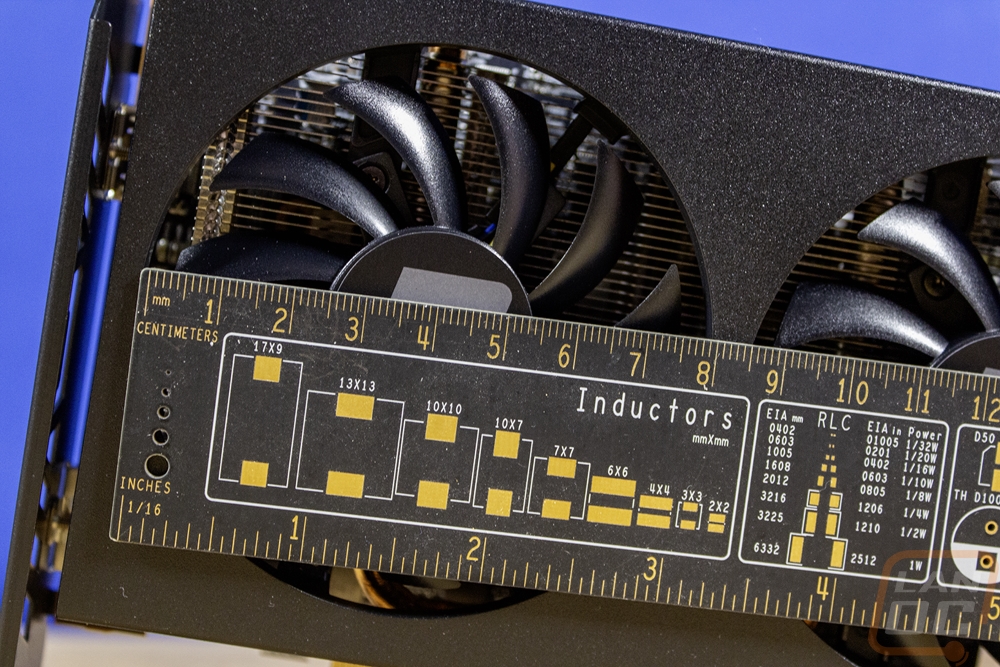

Up on the top edge of the RX 6500 XT Fighter the fan shroud only wraps around slightly and being a budget card PowerColor has kept things simple. There isn’t any lighting or anything, you just have the PowerColor logo and Radeon logo printed on the black shroud in white. Also on top is the power connection which is down at the end of the PCB. It has one 8-pin connection to handle things.


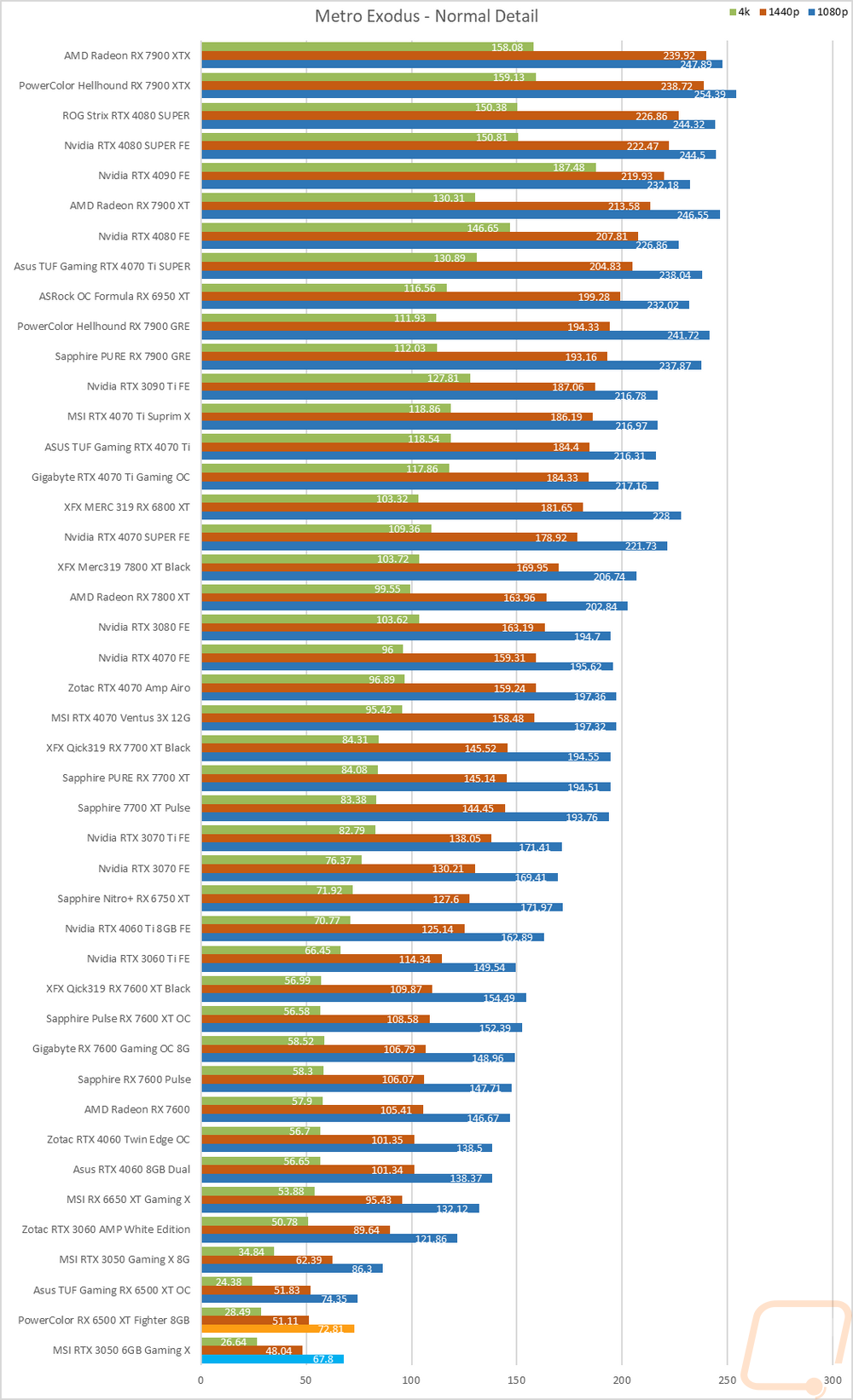
Working our way around the top, bottom, and end of the PowerColor RX 6500 XT Fighter 8GB we can see how that front fan shroud doesn’t wrap around the card very far at all. There is just enough on the top for the branding to be printed on it. It also gives a much better look at the heatsink’s orientation which runs horizontally from end to end on the card. With that, though the card would look a little better on top if it wrapped all the way to the PCB given that area isn’t really needed for airflow like a normal vertical heatsink would need. At the end of the PowerColor RX 6500 XT Fighter 8GB, the heatsink extends out past the PCB and does blow through in that section so the small wrap-around on the shroud on that end isn’t hurting airflow at all. Then on the bottom, we can see the heatpipe layout with three heatpipes in total that all sit over the GPU and then pull heat out to the ends of the heatsink with the U-shaped heatpipes. The bottom view also shows how the heatsink fits tight around each component with cutouts around each capacitor.




The back of the PowerColor RX 6500 XT Fighter 8GB has a metal backplate with a brushed aluminum finish in black that covers all of the length of the PCB. The cooler does stick out past the end of the PC though giving a small blow-through section. The backplate isn’t fancy at all, there isn’t any branding on it or any cutouts. But getting a backplate at all on a budget-focused card is still nice to see. Beyond the QC verification sticker and one dot covering one of the mounting screws, there is just one sticker in the bottom right corner with the model information and serial number all on it.


It’s interesting that the PowerColor RX 6500 XT Fighter 8GB has a blacked-out PCI bracket when the higher-end cards seldom have them, The PowerColor RX 6500 XT Fighter 8GB has the PowerColor logo cut out in the bracket along with a few arrow vent holes as well. With the cooler design which pushes air in this direction, the ventilation will come in handy. For display connections, things are limited with just two connections in total. One is an HDMI and a DisplayPort. I would like to see a full 4 connection layout like most cards on the chance anyone is looking to run more displays.

Test Rig and Procedures
Test System
CPU: Intel Core-i9 13900K – Live Pricing
PL1=PL2: 253, τ: 56 / 307A
Motherboard: Asus Z790 Extreme – Live Pricing
Cooling: Corsair H100i Elite LCD Display - Live Pricing
Noctua NT-H1 Thermal Paste - Live Pricing
Memory: Crucial 32GB Kit (2 x 16GB) DDR5-5600 UDIMM– Live Pricing
Storage: Viper VP4300 Lite 4TB – Live Pricing
Power Supply: be quiet! Dark Power Pro 13 1600W- Live Pricing
Case: Primochill Wetbench - Live Pricing
OS: Windows 11 Pro 64-bit - Live Pricing
|
Our Testing Procedures |
|
|
3DMark |
All 3DMark-based tests are done using the most recent version. We test using all three versions of Fire Strike, Both Time Spy and Time Spy Extreme, and Speed Way. Tests to look at ray tracing performance are done with Port Royal when supported and for Nvidia cards that support DLSS, the DLSS subtest is also done at 1440p with the performance setting and DLSS 2.0 as well as a look at DLSS 1, 2, and 3 at 4K. |
|
Unigine Superposition |
1080p Extreme and 4k Optimized benchmarks along with the VR Future test are done. The VR test is done at the Oculus resolution |
|
VRMark |
Only the Blue room test is run |
|
Far Cry 6 |
Built-in benchmark tested at 1080p, 1440p, and 4k with the Ultra and Medium detail settings |
|
Ghost Recon Breakpoint |
Built-in benchmark tested at 1080p, 1440p, and 4k with the Ultra and Medium detail settings. Texture quality always set to high |
|
Watch Dogs: Legion |
Built-in benchmark testing at ultra and high details. Tested at 1080p, 1440p, and 4k. I also do RTX and DLSS testing on Nvidia cards at 4K using the Ultra detail settings as a base as well. |
|
Borderlands 3 |
Built-in benchmark testing with the ultra detail setting and medium detail setting, done at full screen with default settings at 1080p, 1440p, and 4k on DX11 |
|
Metro Exodus |
Using built-in benchmark, testing at ultra and normal details at 1080p, 1440p, and 4k. I also do RTX and DLSS testing at 4K with the ultra-detail base settings for Nvidia cards as well. |
|
World War Z Aftermath |
Built-in benchmark in DX11 testing both the Ultra detail and Medium detail levels at 1080p, 1440p, and 4K resolutions |
|
The Division 2 |
Built-in benchmark at Ultra detail with V-Sync turned off at 1080p, 1440p, and 4k resolutions. |
|
Total War: Three Kingdoms |
Built-in benchmark using the Battle Benchmark setting. Tested at 1080p, 1440p, and 4k at both high and ultra detail settings |
|
OctaneBench 2020.1 |
OctaneBench is designed to test rendering in OctaneRender. RTX and non-RTX are both ran. This is a CUDA-only test so only Nvidia cards are tested |
|
V-Ray 5 |
V-Ray 5 benchmark us run with CUDA and RTX settings on cards that support it |
|
Boundary Benchmark |
Testing different DLSS detail levels on cards that support it. All testing is done at 4k with RTX on |
|
Bright Memory Infinite RTX Benchmark |
Benchmark all of the different RTX detail levels. Resolution at 4k and DLSS on balanced for each test |
|
Passmark Performance Test 10.2 |
Test using the GPU Compute Score inside of PassMark's Performance Test 10.2 |
|
Blender |
Using the standard Blender Benchmark I run the test using the Blender 3.4 setting which tests using the Monster, Junkshop, and Classroom tests. |
|
Temperature Testing |
Using AIDA64, the GPU stress test is run for 30 minutes or until the result has leveled off. The test is run twice, once with the stock fan profile and a second time with 100% fan speed. During this, I also document the 100% fan speed RPM and document the delta between the fan profile and 100% fan speed as well as get thermal images. |
|
Power Testing |
Using a PCat v2 to monitor power between the PCIe slot and the card as well as power through the power cables I test the peak power when running ADIA64, 3DMark Speed Way, 3DMark Time Spy Extreme, FarCry 6 at 4k and Ultra Detail, Watch Dogs Legion at 4K and Ultra detail, and Blender 3.4.0. The results are then averaged as well as the highest result. |
|
Noise Testing |
Our Noise testing is done using a decibel meter 18 inches away from the video card on the bottom/fan side of the card. We test at 50% and 100% fan speeds as well as a third test while under load using AIDA64's stress test. This is done using a Protmex PT02 Sound Meter that is rated IEC651 type 2 and ANSI S1.4 type 2. Tests are done set weighted to A and set to a slow response using the max function. The ambient noise level in the testing area is 33.3 decibels. |
Synthetic Benchmarks
As always I like to start my testing with a few synthetic benchmarks. 3DMark especially is one of my favorites because it is very optimized in both Nvidia and AMD drivers. It's nice to not have to worry about it being favored too much either way and the repeatability of the results makes it a nice chance to compare from card to card, especially when comparing with the same GPU. In this case, I am curious how the previously reviewed overclocked TUF 6500 XT compares to the PowerColor RX 6500 XT Fighter 8GB because it is the lower memory model. Then, of course, I want to see how the RTX 3050 6GB compares as well which is why I have that card highlighted as well. That is Nvidia’s direct competitor to the 6500 XT 8GB.
The first round of tests were done in the older Fire Strike benchmark which is a DX11 test. There are three detail levels, performance, extreme, and ultra. The PowerColor RX 6500 XT Fighter 8GB is right with the 8GB RTX 3050 and the overclocked 4GB 6500 XT in all three of these tests with the 6GB 3050 being down below with a noticeable gap between the two.


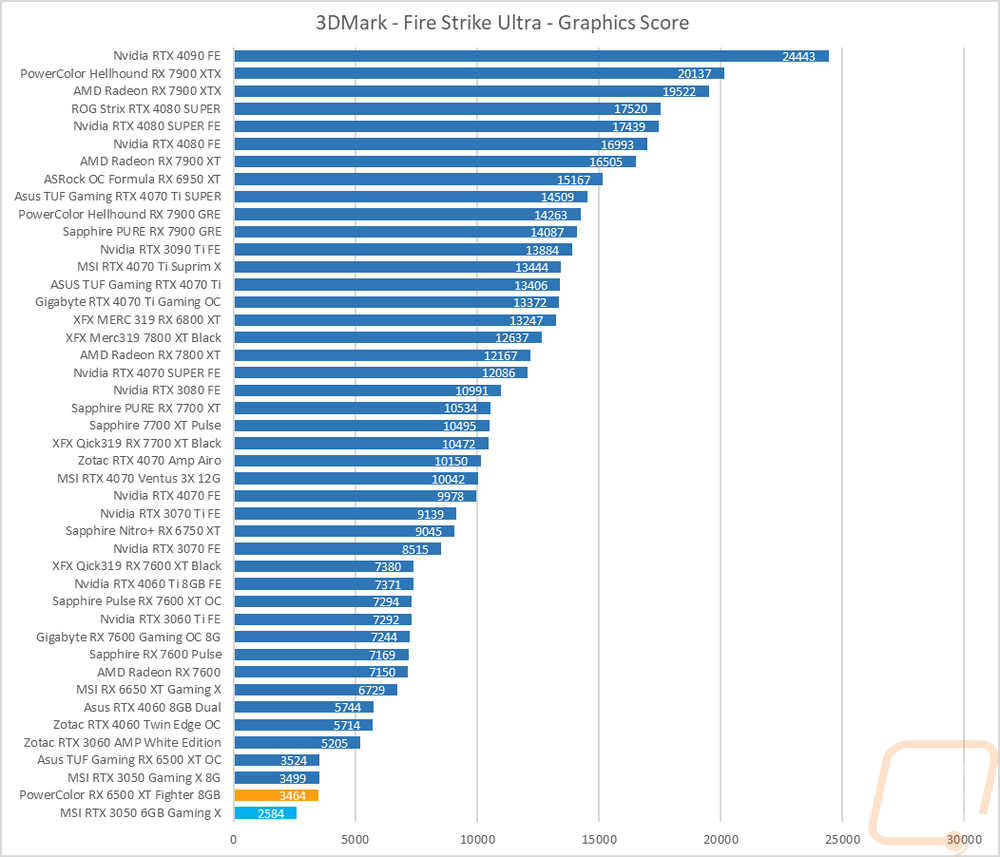
The next two were both based on the Time Spy benchmark. One is the standard test and then there is the extreme detail level. Time Spy is a DX 12 based test and the gap between the PowerColor RX 6500 XT Fighter 8GB and the 6GB RTX 3050 is a lot smaller here but the PowerColor RX 6500 XT Fighter 8GB is still out in front in both tests.
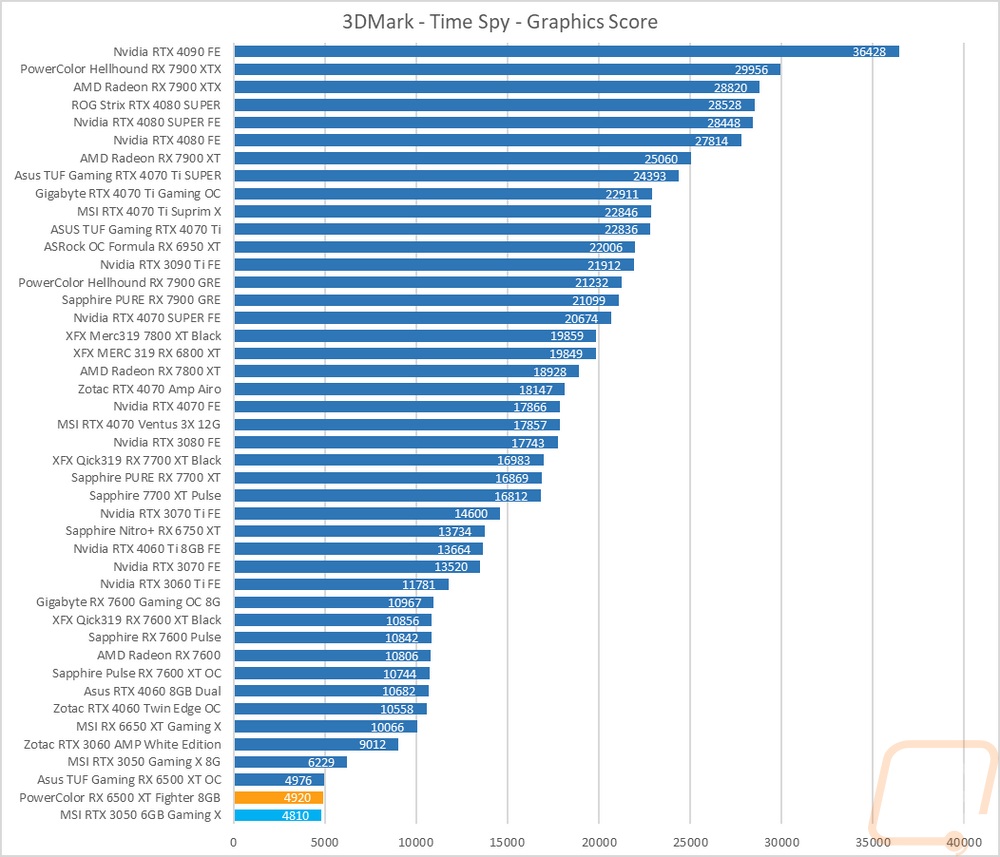

For ray tracing performance, I ran both the 3DMark Port Royal test which is ray tracing focused as well as the new 3DMark Speed Way test which tests all future-looking features including ray tracing. In Speed Way, the PowerColor RX 6500 XT Fighter 8GB scored an 827 which was below the RTX 3050 6GB. The extra VRAM comes into play when compared to the 4GB 6500 XT with it struggling to complete the test at all. The Port Royal test was similar but with an even bigger gap between the 4GB and 8GB 6500 XT.


I couldn’t forget AMD FSR 2 testing when running our 3Dmark tests. For this, everything was tested at 4K which is way beyond the target resolution of the 6500 XT but it did still complete the tests. The extra VRAM helped it outperform the 6500 XT 4GB in the FSR2 and higher quality tests but the overclock on that card did give it an advantage in the ultra-performance and performance settings.

The last test was using the Unigine-based Superposition benchmark and I tested at 1080p with the extreme detail setting as well as the 4K optimized setting. In the extreme detail 1080p setting the PowerColor RX 6500 XT Fighter 8GB came in ahead of the 3050 6GB but a hair behind the overclocked 6500 XT. The 3050 did however edge out in front for the 4k test which was interesting.

VR Benchmarks
As for Virtual Reality, I love it but it is more demanding than traditional gaming. This is partially because of the resolutions needed to render for two eyes and because they render more than what is immediately visible. But also because of post effects to get the proper “fisheye” effect for it to look proper in your eyes with the HMD. You also have to have much higher expectations for frame rates in VR, skipping frames or lower FPS can cause motion sickness in VR. Because of that, I ran a few tests.
My first test was again in Superposition. This time I tested the VR Future test using the Oculus resolution. I have also included the average frame rate as well which is important for the cards at the top of the chart because for some reason Superposition is capped at 10,000 for its scores and that doesn’t show the performance gap in those cards at the top. The PowerColor RX 6500 XT Fighter 8GB and the RTX 3050 are within 02 FPS of each other on this test and just 2 points away as well. The overclocked 6500 XT does edge out slightly but is in the same range as well.

My second round of VR testing was in VRMark which has three tests that are similar to the VR tests in Superposition. I only focused on just the most demanding test called Blue Room which is looking more at future VR performance. The PowerColor RX 6500 XT Fighter 8GB and the 4GB 6500 XT have the same score here but the RTX 3050 does edge out in front on this test.

In-Game Benchmarks
Now we finally get into the in game performance and that is the main reason people pick up a new video card. To test things out I ran through our new benchmark suite that tests 8 games at three different resolutions (1080p, 1440p, and 4k). Most of the games tested have been run at the highest detail setting and a mid-range detail setting to get a look at how turning things up hurts performance and to give an idea of if turning detail down from max will be beneficial for frame rates. In total, each video card is tested 42 times and that makes for a huge mess of results when you put them all together. To help with that I like to start with these overall playability graphs that take all of the results and give an easier-to-read result. I have one for each of the three resolutions and each is broken up into four FPS ranges. Under 30 FPS is considered unplayable, over 30 is playable but not ideal, over 60 is the sweet spot, and then over 120 FPS is for high refresh rate monitors.
So how did the PowerColor RX 6500 XT Fighter 8GB do? Well, this is a 1080p-focused card, so it isn’t a surprise that at 4k a majority of the results were below 30 FPS. At 1440p though some results weren’t too bad with 4 results averaging over 60 FPS and 9 that were playable but not smooth in that 30 to 60 FPS range. At 1080p though all of our tests were playable. There were 6 results in that 30 to 60 FPS range where I would still consider playing with the detail settings to get up over 60 FPS. But a majority of the results were between 60 and 119 FPS with 8 results there and there was one up over 120 FPS as well.



To get a better look at how the PowerColor RX 6500 XT Fighter 8GB compares with the 6GB RTX 3050 I did average out all of the results at all three resolutions. I included the overclocked 6500 XT Asus TUF card. At 1080p the PowerColor RX 6500 XT Fighter 8GB leads here with over 4 FPS average over the RTX 3050 6GB but the really interesting part is seeing how the overclocked 6500 XT 4GB had multiple results even at 1080p where its lower VRAM held it back putting it 11 FPS behind the PowerColor RX 6500 XT Fighter 8GB. At 1440p the gap between the 3050 and the PowerColor RX 6500 XT Fighter 8GB is closer but still has the 6500 XT ahead. Then at 4k, the 3050 jumps ahead, even with having 2GB less VRAM.
|
|
1080p |
1440p |
4k |
|
Asus TUF Gaming RX 6500 XT OC |
61.5 |
34.5 |
16.5 |
|
MSI RTX 3050 6GB Gaming X |
68.2 |
46.3 |
23.2 |
|
PowerColor RX 6500 XT Fighter 8GB |
72.9 |
47.9 |
21 |
Of course, I have all of the actual in game results as well for anyone who wants to sort through the wall of graphs below. None of these results will be a surprise if you already saw the averaged numbers in the table above.
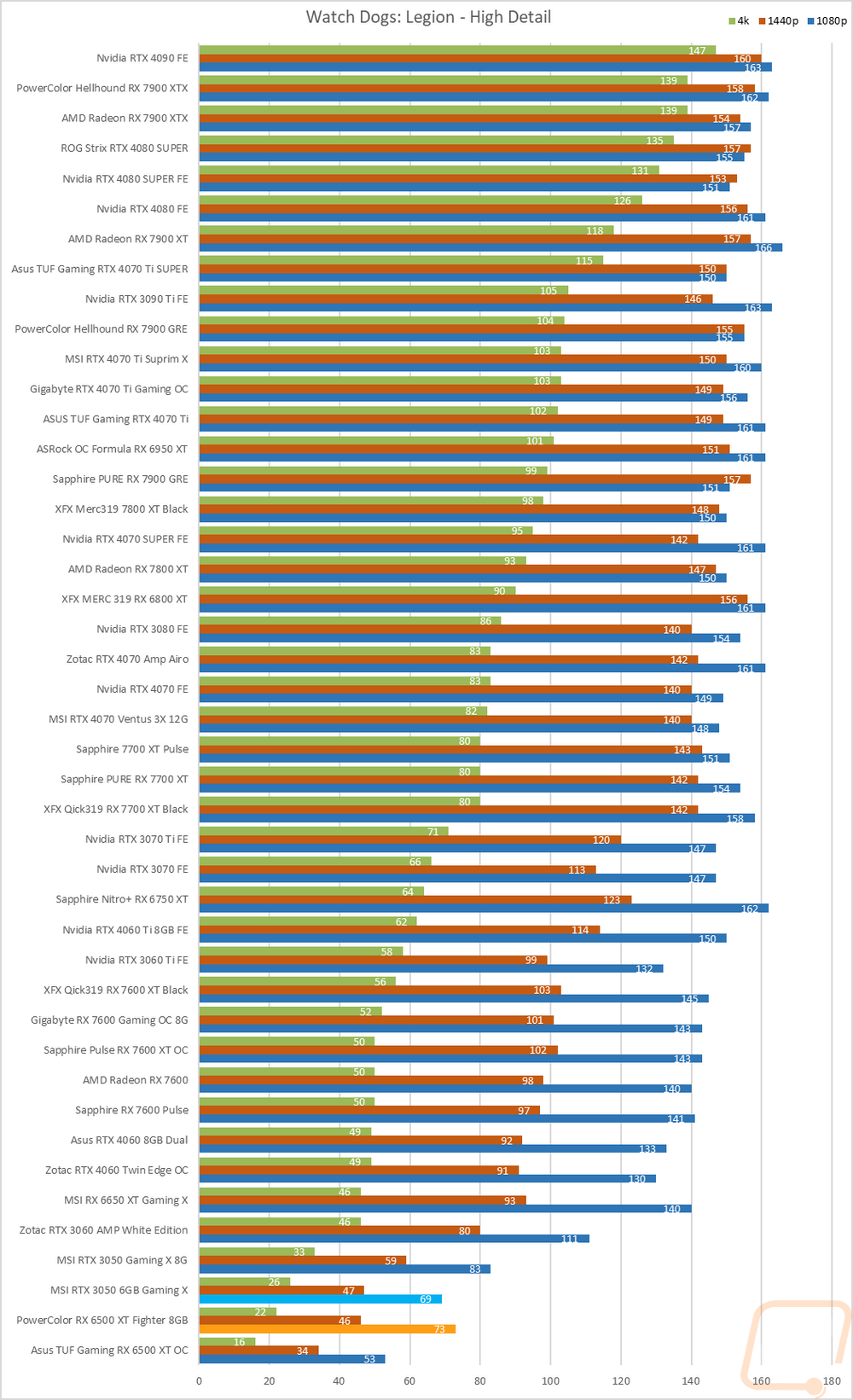





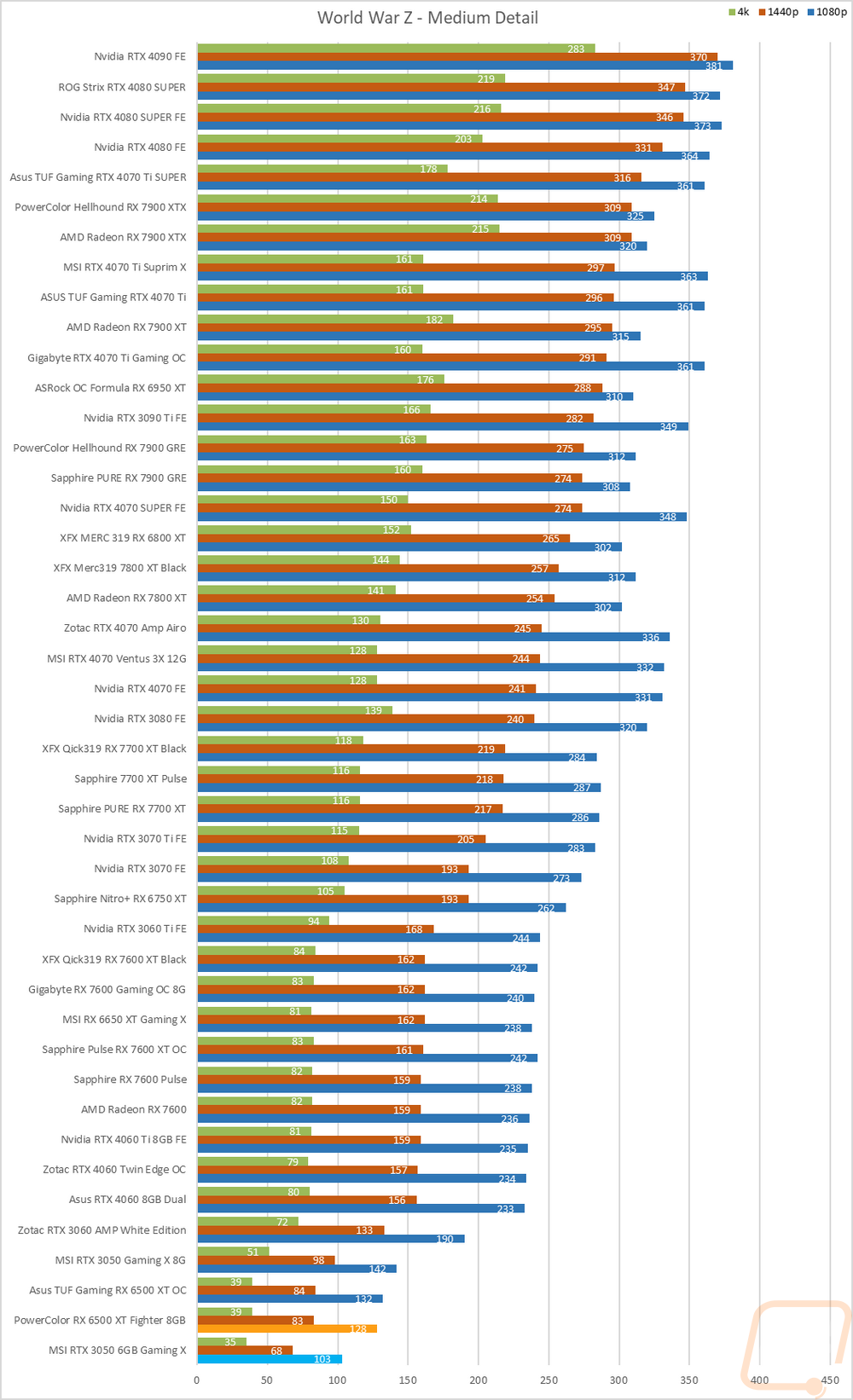


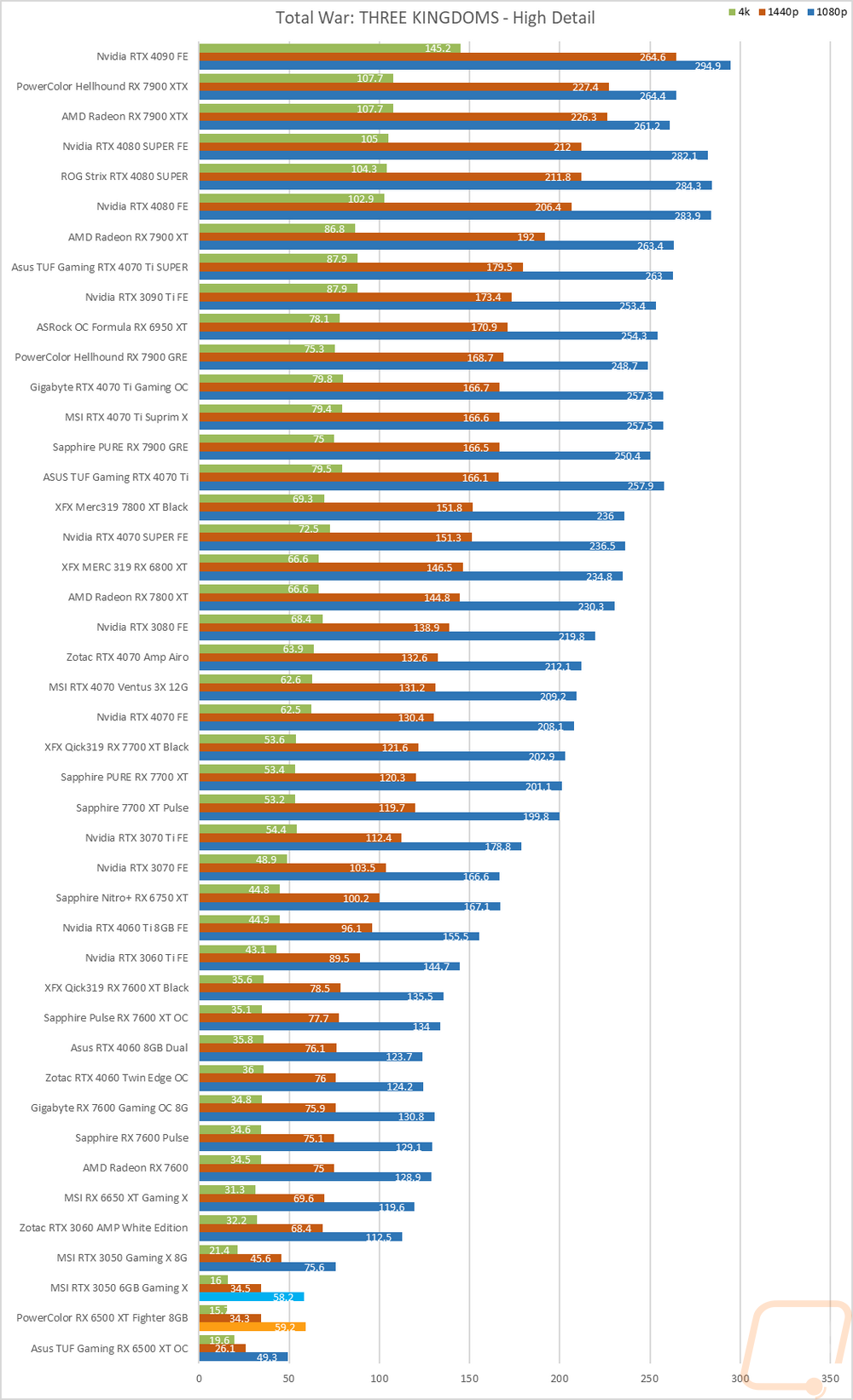
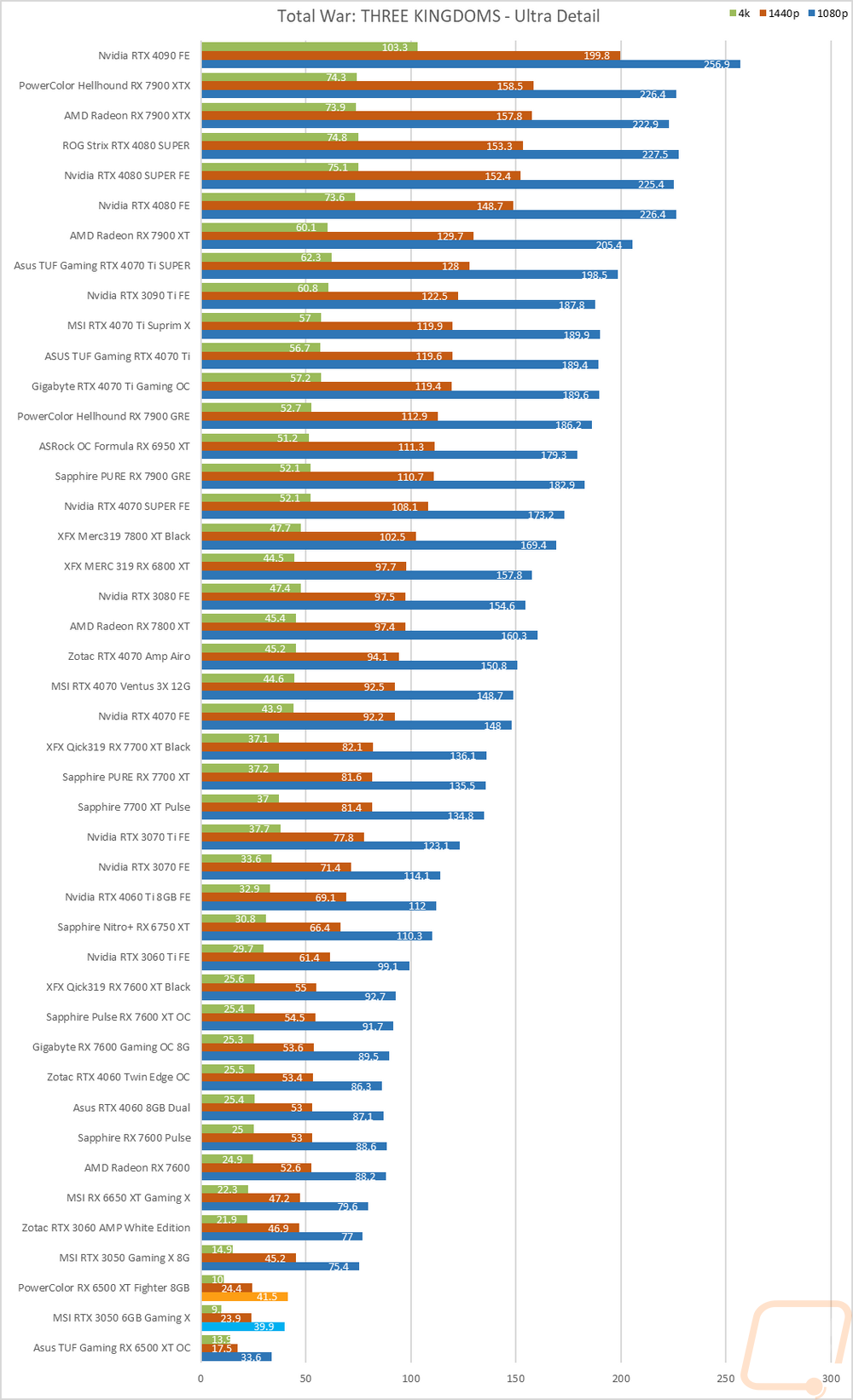



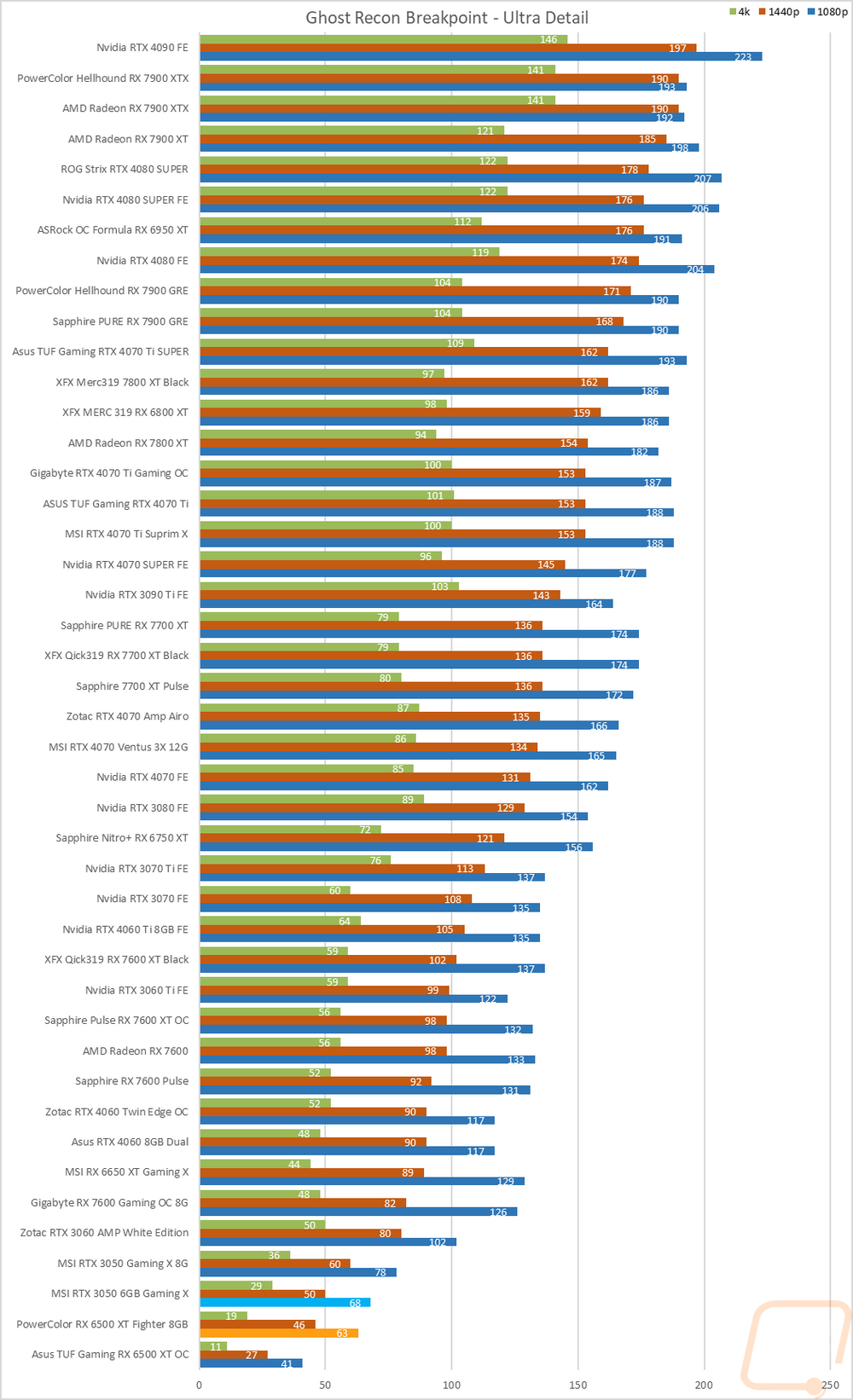
Compute Benchmarks
Now some people don’t need a video card for gaming, they need the processing power for rendering or 2D/3D production, or in some cases, people who game also do work on the side. So it is also important to check out the compute performance on all of the video cards that come in. That includes doing a few different tests. My first test was a simple GPU Compute benchmark using PassMark's Performance Test 10 and the PowerColor RX 6500 XT Fighter 8GB scored a 5565 here which was 200 points above the overclocked 4GB 6500 XT but still came in below the RTX 3050 6GB which scored a 6136.

Blender is always my favorite compute benchmark because the open-source 3D rendering software is very popular and it isn’t a synthetic benchmark. With the latest version of Blender, they redid the benchmark so we now have a new test that runs three different renderings and gives each a score. I have all three stacked together so we can see the overall performance. The PowerColor RX 6500 XT Fighter 8GB and with that the original 4GB 6500 XT both struggled in all three of the Blender tests. The RTX 3050 6GB is down at the bottom of the charts as well but was still noticeably ahead of the PowerColor RX 6500 XT Fighter 8GB in all three tests.
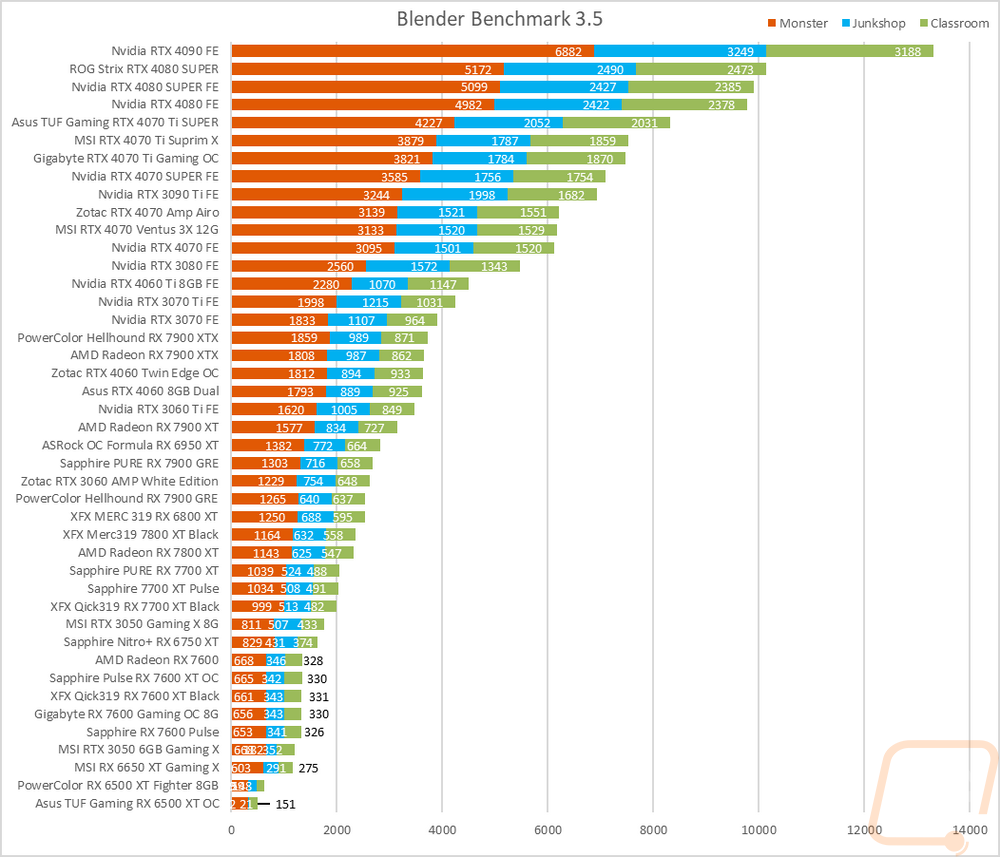


Cooling Noise and Power
For my last few tests, rather than focusing on in game performance, I like to check out other aspects of video card performance. These are also the most important ways to differentiate the performance between cards that have the same GPU. To start things off I took a look at power usage.
For this, our new test setup utilizes the Nvidia-designed PCat v2 along with cables to handle both traditional 6 or 8-pin connections as well as the new 12VHPWR. The PCat also utilizes a PCIe adapter to measure any power going to the card through the PCIe slot so we can measure the video card wattage exclusively, not the entire system as we have done in the past. I test with a mix of applications to get both in game, synthetic benchmarks, and other workloads like Blender and AIDA64. Then everything is averaged together for our result. I also have the individual results for this specific card and I document the peak wattage results as well which is almost always Time Spy Extreme. The PowerColor RX 6500 XT Fighter 8GB peaked at 159 watts which surprisingly was higher than the overclocked TUF 6500 XT 4GB. The RTX 3050 6GB on the other hand was down at the bottom of the chart. As a whole Nvidia’s cards have been more power efficient and with that not being an overclocked card where our original 3050 8GB was overclocked and pulled a lot more wattage. The averaged power numbers for the PowerColor RX 6500 XT Fighter 8GB were lower at 127 watts which wasn’t too bad as well.
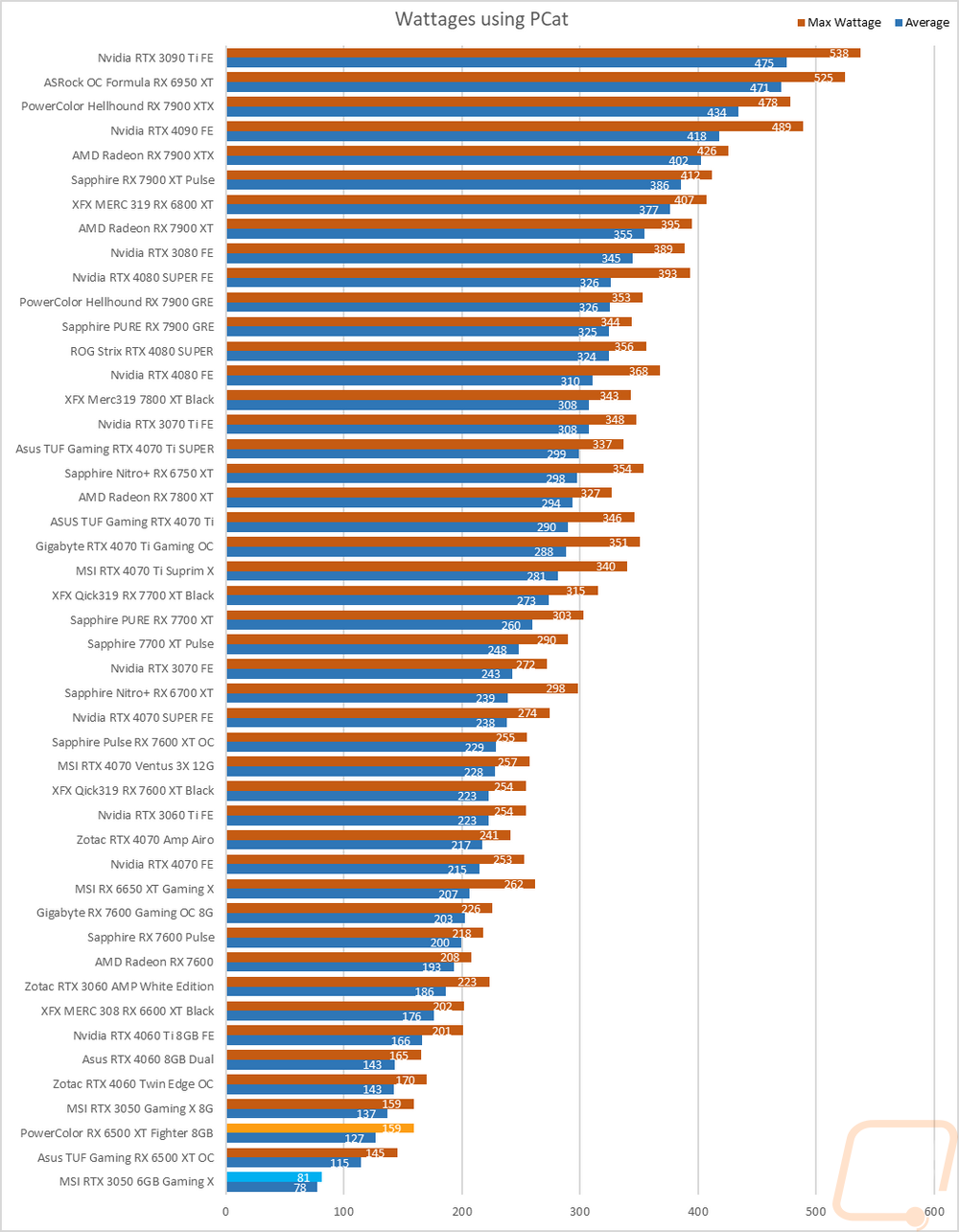

With having exact peak wattage numbers when running Time Spy Extreme I was also able to put together a graph showing the total score for each watt that a card draws which gives us an interesting look at overall power efficiency in the popular and demanding benchmark. This is in line with what we saw in the other power numbers but the PowerColor RX 6500 XT Fighter 8GB didn’t do well in overall efficiency, especially when compared to the RTX 3050 6GB which doesn’t have a PCIe power connection.
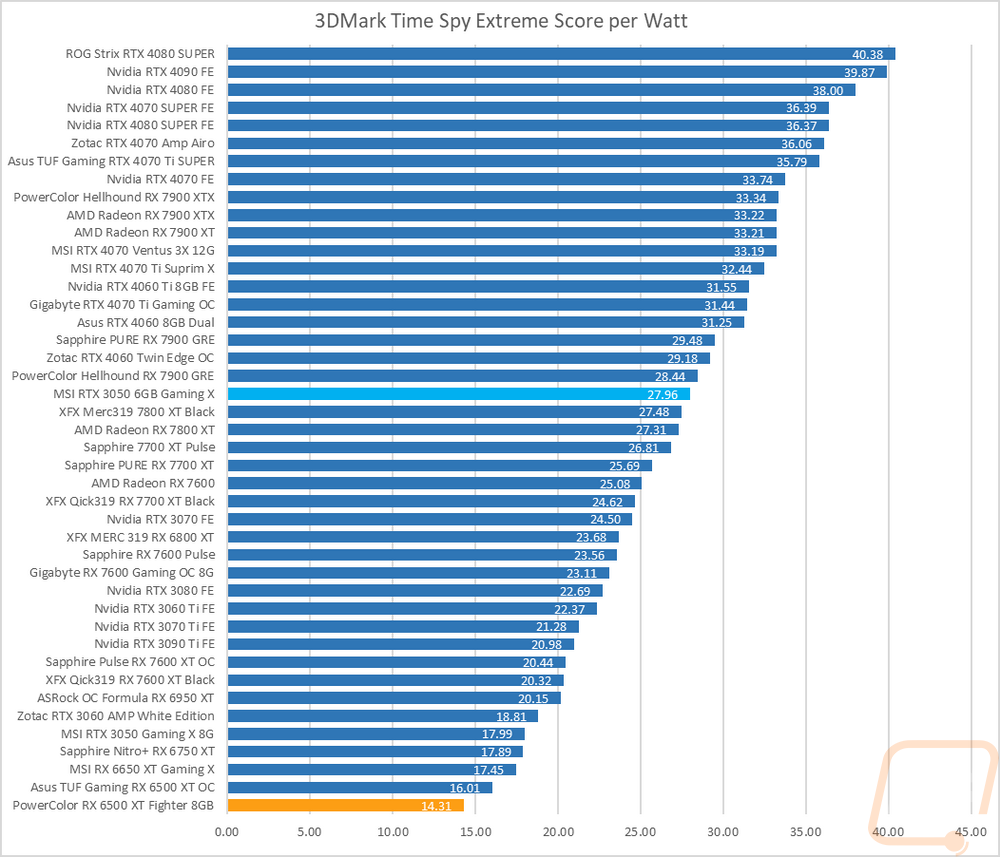
My next round of tests were looking at noise levels. These are especially important to me because I can’t stand to listen to my PC whirling. Especially when I’m not in game and other applications are using the GPU. For my testing, though I first tested with the fan cranked up to 100% to get an idea of how loud it can get, then again at 50% to get an idea of its range. The PowerColor RX 6500 XT Fighter 8GB was in the middle of the pack at 50% fan speed but with the dual fans cranked up it did well and is in the bottom 1/3 of our chart at 57.2 dB. This is impressive because as you can see in the third chart the PowerColor RX 6500 XT Fighter 8GB is up near the top of the chart in overall fan speed.



I also take a look at noise performance while under load. For that when running AIDA64’s stress test I wait until the temperature of the card has leveled off and then measure how loud things are when the card is at its worst-case scenario with the stock fan profile. Here the PowerColor RX 6500 XT Fighter 8GB did well sitting at 35.5 dB when under load. For comparison, the MSI RTX 3050 6GB which was quieter in some of the other tests is 2 dB higher here. The chart showing where each card was sitting for fan speed percentage matches this with the PowerColor RX 6500 XT Fighter 8GB running at 44% of its fan speed when under load whereas the RTX 3050 6GB was at 48%.


To finish up my testing I of course had to check out the cooling performance. To do this I ran two different tests. I used AIDA64’s Stress Test run for a half-hour each to warm things up. Then I documented what temperature the GPU leveled out at with the stock fan profile and then again with the fans cranked up to 100%. With the stock profile, the PowerColor RX 6500 XT Fighter 8GB was running at 65c which was 3 degrees above the RTX 3050 6GB. Its GPU Hotspot was running at 86c vs the 3050 was lower at 74c. Then with the fans cranked up, the PowerColor RX 6500 XT Fighter 8GB dropped down significantly to 50c. This matched up exactly with the RTX 3050 6GB as well. This was a delta of 15c between the two results which is bigger than I normally see but this does also explain why its noise performance while under load was a little better.

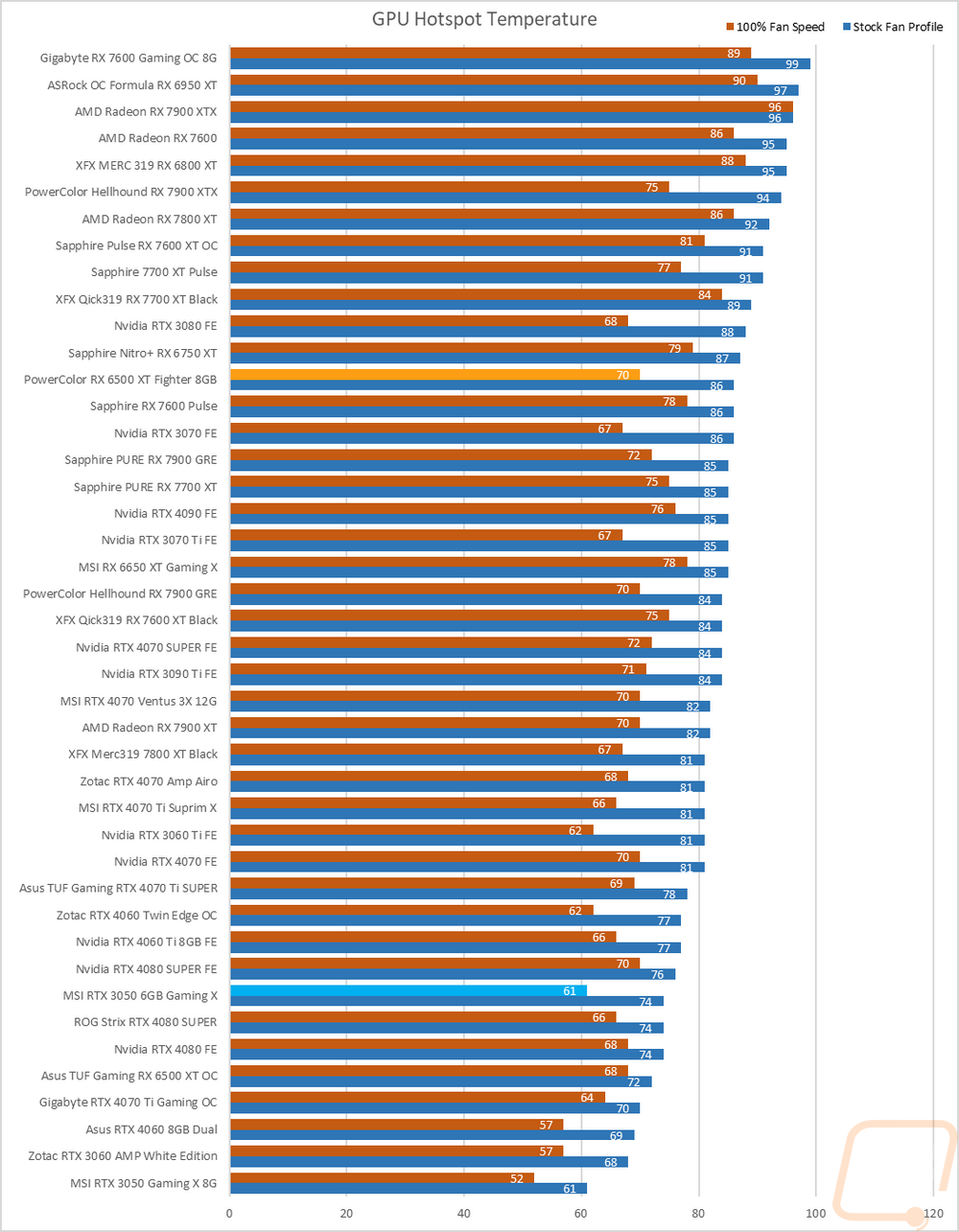
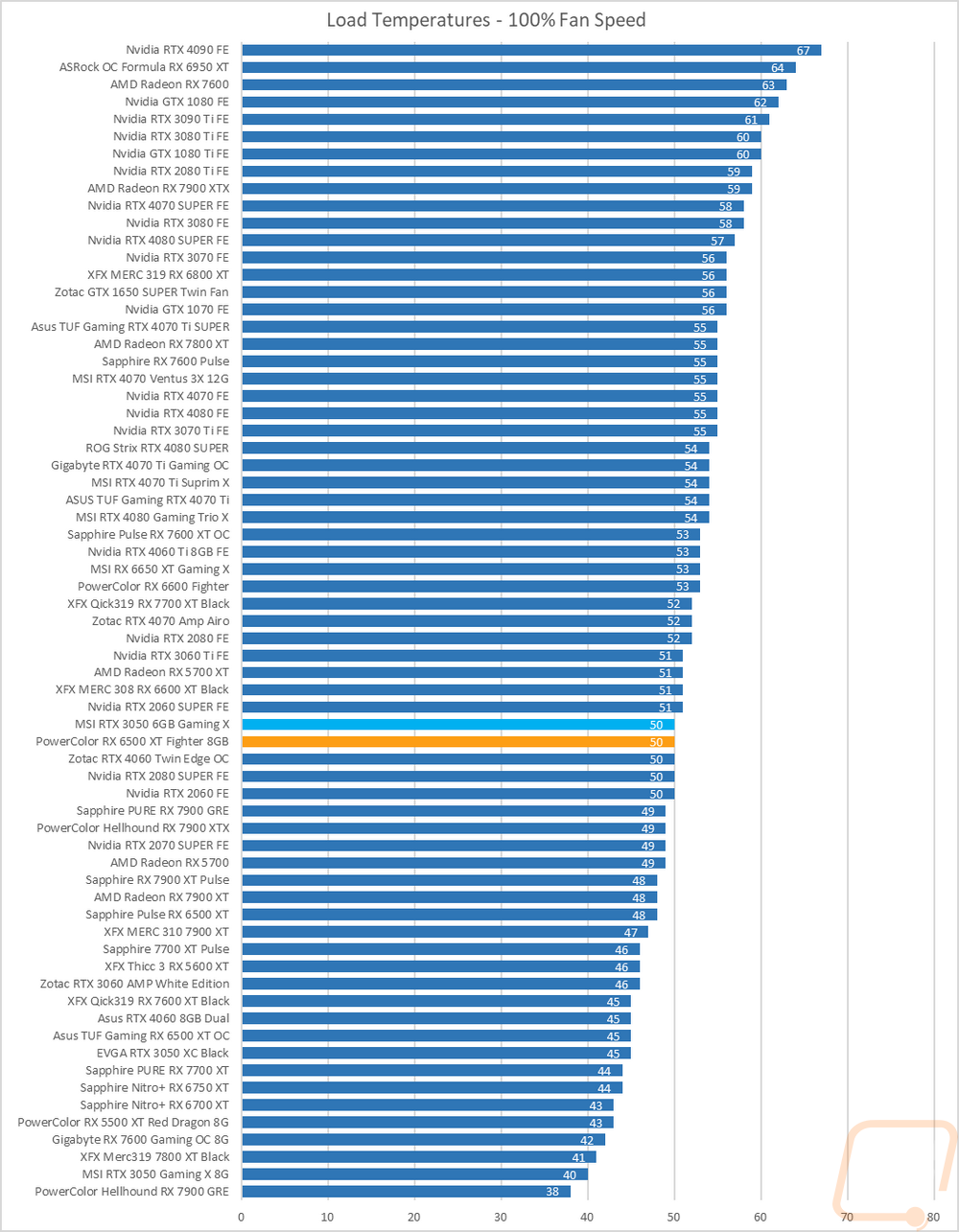

While running the stock fan profile testing I also took the time to get a few thermal images so we could see what is going on. On the fan size, there are a few areas that pick up at 57.5, those are below the heatsink on the exposed PCB and the heatpipes that wrap around on the bottom. But you can also see that outside of behind the fans it does get noticeably warmer on the cooler as well. Up on the top edge, you don’t have the heat blowing out the top but we can see the PCB directly so there are still hot spots there, especially near the center above the GPU, it is a lot cooler down towards the end of the card. The back is mostly consistent with the backplate covering everything but at 52c to 64c it is toasty warm with the part of the heatsink that extends past the PCB running cooler at 47c.



Overall and Final Verdict
Like I said at the beginning, the budget-friendly cards may not be flashy or even exciting. These are however the meat and potatoes of the GPU market. Still to this day, a majority of users are gaming at 1080p or sometimes even lower and a big expensive video card isn’t going to be the right purchase if that is the resolution that you are playing at. AMD and Nvidia do have cards focused on high refresh gaming at 1080p as well and this isn’t the target for the PowerColor RX 6500 XT Fighter 8GB tested here as well. What we saw for performance was a card capable of playing anything you throw at it at 1080p with a few of those games maybe needing the detail dropped down just slightly to get that smooth 60+ frame rate. What was surprising however is how the additional VRAM changed performance even when comparing performance with the overclocked 6500 XT 4GB at 1080p. It was a bigger difference than expected but only in some games and mostly at the highest detail settings. The competing RTX 3050 6GB came in behind the PowerColor RX 6500 XT Fighter 8GB at 1080p. At the highest resolutions the 3050 did jump ahead, but those were resolutions and frame rates you wouldn’t be playing on either card. In the end, the 6500 XT 8GB was notably better for raster performance but like we saw in the higher-end cards the 3050 6GB was still better when new technology like ray tracing was introduced in tests like 3Dmark Speed Way and Port Royal.
As for the PowerColor RX 6500 XT Fighter 8GB itself, I was surprised with the overall card design. It is of course compact and barebones. But PowerColor went fully barebones when it came to styling with the blacked out all flat fan shroud design. On the other end of the spectrum though the card still has a metal backplate which a lot of budget cards don’t get at all or sometimes get a plastic backplate that transmits no heat. They even went as far as to paint the PCI bracket black to match proving that we should be seeing that even more on higher-end cards if cheaper cards can get the feature. My only complaints would be the need for at least one more display connection. You get one HDMI and one DisplayPort which covers what you should need, but it is nice to get two matching connection types and open up the possibility of hooking up three displays for those who might need it. I would also love to see in future cards focused on this performance/resolution to get an option that doesn’t have a PCIe power connection at all. The RTX 3050 6GB doesn’t have one due to it being more power efficient and it opens it up to being able to use it as an upgrade for a cheap prebuilt without having to worry about having the power connections needed to power the GPU.
For pricing the PowerColor RX 6500 XT Fighter 8GB is available both at Newegg and Amazon for $179.99. The RTX 3050 6GB from Nvidia can be found at that same price but seems to favor being a little higher for a lot of the models. Considering the overall value it is going to depend on what games you are looking to play because for some people the significantly cheaper 6500 XT 4GB is going to be the best deal with at least one model selling for $139.99. There is a noticeable performance difference at 1080p in some games with the additional VRAM for the 8GB model even with our 4GB model being overclocked and this one not being overclocked. When averaged across all of the games this was a 10 FPS difference but that doesn't tell the whole story. In some games, they perform almost exactly the same but in games like Ghost Recon, Far Cry 6, and Watch Dogs: Legion the 4GB model was under 60 FPS and the 8GB model was 20 FPS higher or more. There were other examples where they were both under 60 FPS and both over 60 FPS as well. Because of that, the 6500 XT 8GB feels like the floor on what I would recommend for 1080p gaming. Of course, looking above the 6500 XT 8GB there are closely priced options like AMDs RX 6600 as well which most run $199 but there is one model at Newegg selling for $189 and is a great way to get a performance bump for just little more. You then have the 6650 XT for $219 and then you get into the RX 7600 and RTX 3060 range. Those are still going to get you a huge jump in performance if you have the budget. Overall there are a few options that open up the possibility of building a budget PC again.

Live Pricing: HERE




